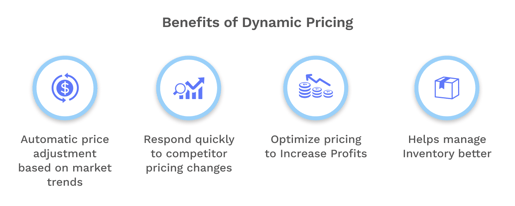What is Dynamic Pricing: Strategies, Benefits, and Examples
What is Dynamic Pricing: Strategies, Benefits, and Examples
As businesses seek innovative methods to stay responsive to customer needs, dynamic pricing emerges as a crucial strategy for adapting prices in real-time according to varying demand and other market factors. This flexible pricing approach enables companies to adjust their strategies swiftly, ensuring their offerings remain attractive and competitive under varying market conditions.
Through this article, we will uncover the mechanics behind dynamic pricing, its advantages, and examples that illustrate its effectiveness.
Quick Takeaways
- Dynamic pricing adjusts prices in real-time based on market factors such as demand, competition, and consumer behavior to help businesses stay competitive and maximize revenue.
- The shift from manual price adjustments to automated, data-driven dynamic pricing models is driven by advancements in digital technology and data analytics.
- Dynamic pricing includes strategies like demand-based, time-based, segment-based, and penetration pricing to optimize sales, profitability, and market penetration.
- AI enhances dynamic pricing by using predictive analytics and machine learning to analyze data and make informed, real-time pricing decisions, thereby improving strategy accuracy and effectiveness.
Understanding Dynamic Pricing
Dynamic pricing is a strategy that adjusts the price of products or services in real-time based on various market factors such as:
- Demand
- Competition
- Consumer behavior
This approach allows businesses to remain competitive and maximize revenue by aligning prices with current market conditions.
The concept of dynamic pricing is not new; it has roots in traditional economic theories of supply and demand. Historically, businesses adjusted prices manually based on seasonal changes or occasional promotions.
However, with the advent of digital technology and data analytics, pricing strategies have evolved into dynamic models that respond automatically to minute-by-minute market changes. This evolution marks a shift from static pricing models to more flexible and responsive strategies.

Key Principles of Dynamic Pricing
Demand-based Pricing
This principle involves adjusting prices in accordance with the current demand levels. High demand can trigger higher prices, while lower demand may lead to discounted rates, optimizing sales and profitability throughout varying demand cycles.
Time-based Pricing
Time-based pricing refers to altering prices at different times of the day, week, or year to reflect changes in demand. For instance, prices may be higher during peak hours or seasons and lower during off-peak times, effectively managing consumer influx and maximizing revenue across different time periods.
Segment-based Pricing
Segment-based pricing involves setting prices according to different customer segments. Factors such as location, buying behavior, and customer loyalty can influence how prices are set for specific groups, allowing companies to tailor their pricing strategies to the characteristics of each segment.
Penetration Pricing
This strategy is used when launching new products. By setting prices low initially, businesses can attract a large number of customers quickly, helping to establish market share and customer base before potentially raising prices in the future.
Benefits of Dynamic Pricing

Increased Profitability Through Optimized Pricing
Dynamic pricing enables businesses to maximize their profitability by adjusting prices based on real-time market and consumer data, ensuring that pricing decisions are always optimized for current conditions.
Enhanced Competitiveness in the Market
By adapting prices dynamically, companies can stay competitive in a market where prices are constantly fluctuating, ensuring they remain attractive to consumers compared to their competitors.
Improved Customer Segmentation and Targeting
Dynamic pricing allows businesses to understand and segment their customers more effectively, leading to more targeted marketing strategies and better alignment of product offerings with customer expectations.
Flexibility in Responding to Market Changes and Consumer Behaviors
The ability to change prices in real time provides businesses with the flexibility to respond quickly to external market shifts or changes in consumer preferences, maintaining relevance and competitiveness.
Dynamic Pricing Strategies
Real-time Pricing Adjustments Using AI and Machine Learning
Modern dynamic pricing employs advanced technologies such as AI and machine learning to analyze vast amounts of data and automate pricing adjustments. This ensures that pricing strategies are data-driven and reflective of the most current market conditions.
Integrating External Factors
Incorporating external factors such as competitor pricing, economic indicators, and inventory levels into pricing decisions can help businesses refine their pricing models for better accuracy and effectiveness.
Balancing Profit Margins with Customer Satisfaction and Retention
While dynamic pricing focuses on optimizing profit margins, it also considers customer satisfaction and retention. Pricing strategies are designed not just to maximize short-term gains but to sustain long-term customer relationships by offering fair, competitive prices.
AI's Role in Dynamic Pricing
Artificial intelligence (AI) is revolutionizing the way businesses implement dynamic pricing strategies by providing advanced analytical capabilities.

Predictive Analytics and Real-Time Data Processing:
AI systems leverage these tools to enable companies to adjust their pricing in response to evolving market conditions. By predicting future trends and consumer behaviors, AI tools help businesses proactively set prices that are strategically aligned with expected market developments, ensuring optimal pricing at all times.
Technological Foundations of AI-Driven Dynamic Pricing:
- Big Data Analytics: Utilizes vast amounts of data from various sources to analyze market trends.
- Machine Learning Algorithms: These algorithms adapt and improve over time, learning from new data to enhance the predictive accuracy of pricing strategies.
- Predictive Analytics: Focuses on forecasting future market conditions and consumer behaviors to provide precise pricing recommendations.
AI algorithms continuously learn from new data, enhancing their predictive accuracy and the effectiveness of pricing strategies over time.
Maximize Your Revenue Today with Hypersonix
AI-driven dynamic pricing strategies enable businesses to adjust prices in real-time according to market and consumer behaviors, boosting profitability and maintaining competitiveness.
Leveraging technologies like those from Hypersonix for competitor analysis helps companies quickly grasp market dynamics and spot emerging trends. This comprehensive data analysis allows businesses to strategically position themselves, staying ahead of the competition while optimizing their pricing and marketing for maximum revenue and customer satisfaction.
Explore how dynamic pricing strategies powered by AI can elevate your business. Schedule a demo today to see how our solutions can optimize your pricing decisions and enhance market responsiveness!


.png)



